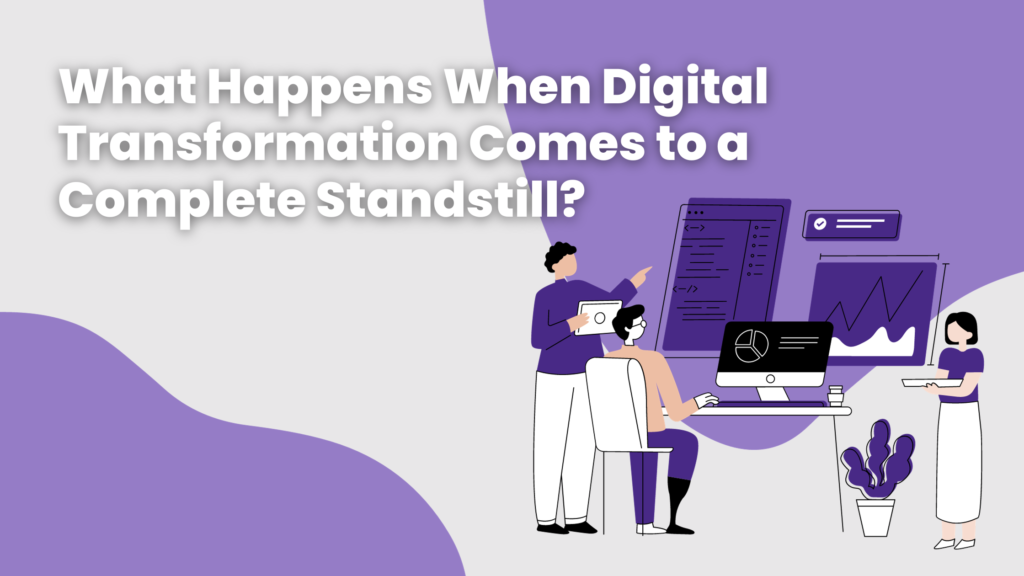The concept of digital transformation has been at the forefront of business strategy for the better part of the last decade. It’s a process that sees companies integrating digital technology into all areas of their business, fundamentally changing how they operate and deliver value to customers. It’s also a cultural change that requires organizations to continually challenge the status quo, experiment, and get comfortable with failure. But what happens when this transformation grinds to a halt?
A standstill in digital transformation can occur for several reasons: budget constraints, technology limitations, lack of leadership, resistance to change, or even a global crisis that forces businesses to prioritize survival over innovation. The repercussions of a standstill can be significant, affecting various aspects of the business and its stakeholders.
Impact on Competitive Edge
Digital transformation is, in many ways, a race. When an organization stops or slows down, it risks falling behind competitors who continue to innovate and adapt. As a result, the company may experience a loss in market share, a decrease in customer satisfaction, and a potential erosion of its brand as a leader in its industry.
Customer Experience Deterioration
In today’s fast-paced digital world, customers expect a seamless, personalized experience across all channels. A halt in digital transformation means a company may not be able to keep up with evolving customer expectations. This could lead to a decrease in customer loyalty and an increase in customer churn.
Operational Inefficiencies
One of the goals of digital transformation is to streamline operations and increase efficiency. A standstill can lead to outdated processes that are slow, error-prone, and cost-intensive. This not only affects the company’s bottom line but also its ability to be agile and responsive to market changes.
Employee Morale and Retention
Employees, especially those who are tech-savvy and forward-thinking, may find a standstill in digital initiatives disheartening. This can lead to decreased morale and engagement, and in some cases, result in a talent drain as employees leave to find more innovative and dynamic workplaces.
Security Risks
Digital transformation often involves updating technology and infrastructure, including security measures. A lack of progress could leave organizations vulnerable to cyber threats. As cyberattacks become more sophisticated, staying current with security technology is crucial.
Strategic Stagnation
Digital transformation is not just about technology; it’s also a driver of strategic innovation. When transformation efforts stop, it can mean that strategic initiatives also stall. Without the ability to experiment with new business models or explore emerging markets, the company may miss out on key opportunities for growth.
Mitigation and Adaptation
However, a standstill is not the end of the road. Companies can mitigate the risks and adapt by taking the following steps:
- 1. Reassess and Reprioritize: Understand what caused the standstill and identify which digital initiatives can offer the most value with the resources available.
- 2. Cultural Reinforcement: Reiterate the importance of a digital-first mindset across the organization, even if progress on some initiatives has paused.
- 3. Customer Engagement: Stay engaged with customers through existing digital channels and reassure them of your commitment to meeting their needs.
- 4. Employee Upskilling: Use the period of standstill to invest in employee training and upskilling, preparing for a time when transformation efforts can resume.
- 5. Security Vigilance: Maintain a strong focus on cybersecurity to protect against new threats.
- 6. Agile Planning: Develop a more flexible digital strategy that can withstand unexpected disruptions and resume with minimal delay.
Conclusion
In conclusion, when digital transformation comes to a complete standstill, it’s not just the technology projects that are put on hold; the entire organization feels the impact. While the standstill may be due to factors beyond the company’s control, it’s important to actively manage the risks associated with the pause in transformation efforts. By doing so, companies can maintain their relevance and be ready to jump-start their digital journey when the time is right.
Know more: Generative AI and the Future of Machine-Assisted Work


